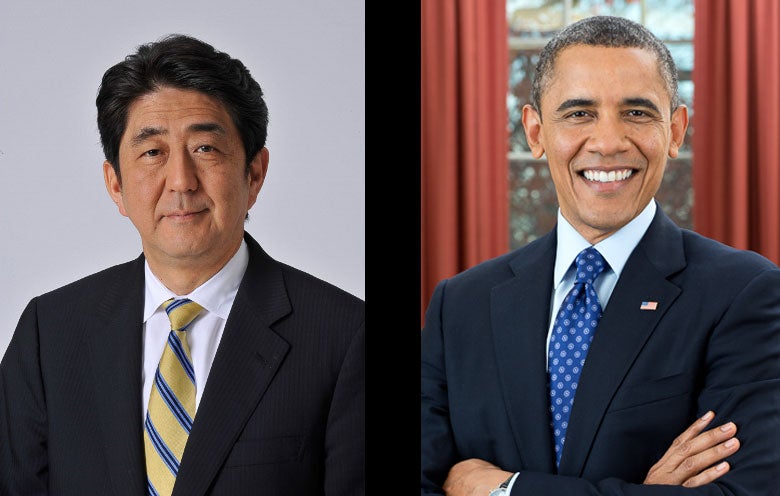Culture and a Nation's Ideal Effect Shapes How Leaders Smile
By Clifton B. Parker

How much a political leader smiles reflects their particular country's cultural values related to how people express themselves, a Stanford scholar has found. In the United States, the smiles of politicians and other leaders tend to be big and wide. In East Asian countries like China and Taiwan, they are much more modest, the research showed. The reason is that how one's culture views smiling influences how people in that culture may smile, said Jeanne Tsai, a Stanford associate professor of psychology and the lead author on a published paper in the journal Emotion.
"Often people think that when they are viewing a candidate's official photo, they are learning about the candidate's unique traits," Tsai said. "But our findings suggest that they are also learning about the candidate's culture and the emotions it values." This smiling effect may have ramifications in the world of politics, Tsai continued. Culturally different emotions and expressions may create misunderstandings between leaders from different nations involved in negotiations or crises.
Tsai directs the Culture and Emotion Lab at Stanford and has previously published research on how Americans tend to embrace positive feelings while Chinese people do not as much; how people from different cultures express sympathy; and how culture factors into why we like or don't like people.
Tsai's most recent research compares the emotional expressions of leaders across different nations. The major finding is that the more a particular nation values excitement (as in the United States), the more their leaders show excited smiles. On the other hand, the more a particular nation values calm (as in East Asian countries), the more those leaders show calm smiles. The reason relates to a nation's "ideal affect," which is defined as culturally valued emotions and how people want to feel, she noted. Different countries, such as China and the United States, diverge in their ideal affects — or how people want to feel.
"It is significant that although democratic and developed nations were more likely to have leaders who smiled in their photos, it was the nation's ideal affect that uniquely determined whether leaders' smiles were more excited or calm," said Tsai.
As part of their research, Tsai and her colleagues conducted three studies. In one they compared the smiles of top-ranked American and Chinese government leaders, chief executive officers and university presidents in their official photos. They found that top-ranked American leaders showed more excited smiles than top-ranked Chinese leaders across all fields.
In the second study, they compared the smiles of winning vs. losing political candidates and higher vs. lower ranking chief executive officers and university presidents in the United States, Taiwan and China. "American leaders showed more excited smiles than Taiwanese/Chinese leaders, regardless of election outcome or ranking," Tsai and her co-authors wrote.
The third study involved self-reported measures of ideal affect among college students from 10 different nations. Eight years later, Tsai and her research team coded the smiles that legislators from those nations showed in their official photos. Tsai and her colleagues found that the more nations valued excitement and other high-arousal positive emotional states, the more their leaders showed excited smiles. "Similarly, the more nations valued calm and other low-arousal positive states, the more their leaders showed calm smiles," they wrote.
Tsai explained that high-arousal positive states are emotions that feel good and energizing. On the other hand, low arousal positive states are emotions that feel good and soothing. She was surprised that the results held across all occupations — beyond politics — and regardless of whether leaders were of higher or lower rank. "I thought they might be more pronounced in occupations that are more visible to the public, like government," she said.
She also expected the findings might be more pronounced for higher ranked than lower ranked leaders, because higher ranked ones might have more knowledge about how their culture views smiling. But they were not — everyone shared the same inclination on smiles, per their culture. "I think the fact that the cultural differences emerged regardless of occupation or rank speaks to how pervasive cultural values regarding emotion are," she said.
The researchers noted that the study controlled for national differences in democratic levels, GDP per capita and human development.
Tsai's co-authors include researchers Jen Ying Zhen Ang, Elizabeth Blevins and Julia Goernandt from Stanford University; Helene H. Fung and Da Jiang from the Chinese University of Hong Kong; Julian Elliott from Durham University; Anna Kölzer from the University of Hamburg; Yukiko Uchida from Kyoto University; Yi-Chen Lee and Yicheng Lin from National Taiwan University; Xiulan Zhang from Beijing Normal University; and Yolande Govindama and Lise Haddouk from Université Paris V.
More Articles
- National Archives Foundation: Archives Experience, A Republic, If You Can Keep It
- Women's Health and Aging Studies Available Online; Inform Yourself and Others Concerned About Your Health
- "Henry Ford Innovation Nation", a Favorite Television Show
- Ferida Wolff's Backyard: Fireworks Galore!
- Journalist's Resource: Religious Exemptions and Required Vaccines; Examining the Research
- Upcoming Exhibitions at the Fashion Institute of Technology (FIT): Head to Toe and Ravishing: The Rose in Fashion
- Jo Freeman Reviews The Daughters of Kobani: A Story of Rebellion, Courage and Justice
- Magazines and the American Experience: Highlights from the Collection of Steven Lomazow, M.D
- Jo Freeman: How to Debate a Bully
- “Housewife” to “Hussy”; A Revisit To Grammarphobia: From Domestic to Disreputable






